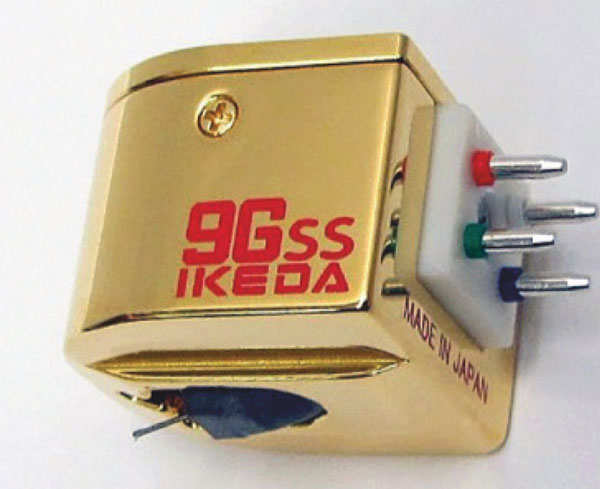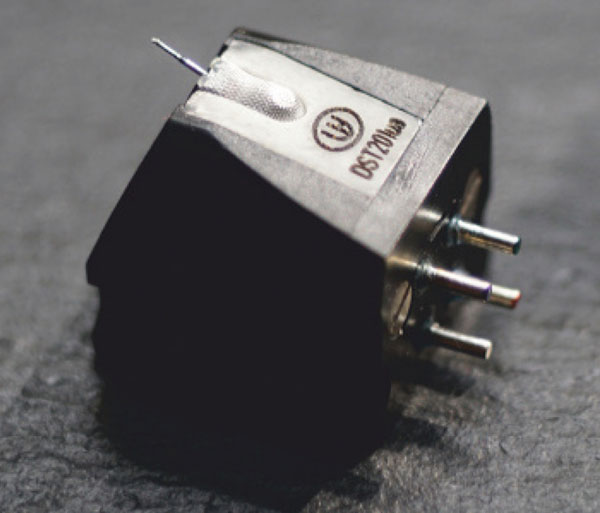| Columns Retired Columns & Blogs |
Our Hi Fi Club refers to that arm as the "Thoreau."
One member calls it the "Mousetrap" after the game of the same name.
If you like or prefer tangential tracking, don't let me discourage you. The Klaudio KD-ARM-AG12 is mechanically ingenious, superbly built—the machining is amazing—sets up and works as intended, and is packed with interesting and useful features, particularly the headshell design, which I hope Klaudio makes available for separate purchase. I just think the tangential obsession is misguided.
Ikeda 9Gss moving-coil cartridge
We've (un)comfortably crossed the $10,000 threshold for phono cartridges. Cartridges with five-figure prices are available from Air-Tight, Grado Labs, Kuzma, Lyra, Ortofon, TechDAS, and van den Hul. Now joining them is Ikeda Sound Labs, with the new 24K-gold–plated 9Gss, to be produced in a limited edition of 200 units ($10,500, footnote 2). I reviewed Ikeda's previous top model, the Kai ($8500), in my June 2015 column.

The Kai produced a very low output of 0.19mV and, not surprisingly, had a very low internal impedance of 2.5 ohms, indicating very few coil-wire turns. Glued to its boron cantilever was a solid diamond MicroRidge line-contact stylus, probably sourced from Namiki. The Kai's cantilever-stylus assembly was similar if not identical to what Lyra and others use in less costly cartridges. The Kai's body was of alumite, an alloy of aluminum, iron, and obsidian, with a titanium top plate. The generator system featured a core of high-efficiency permalloy (nickel-iron) and a magnet system of samarium-cobalt.
Ikeda's 9Gss has a far higher output of 0.3mV (3.54cm/s), which might seem surprising—a higher output usually means more coil turns (thus higher mass and lower resolution)—until you see that the 9Gss's coil impedance is only 0.5 ohm higher than the Kai's. This means that the new generator system, based on a neodymium magnet, is far more efficient: higher output is achievable with no increase in moving mass. That makes the new cartridge far more user friendly.
In the 9Gss Ikeda has also moved to a nude, square-shank, line-contact diamond stylus mounted in a boron cantilever, which appears to made by Ogura. But unlike Lyra's Atlas SL, which has a diamond-coated boron cantilever—or Ortofon's MC Century, Kuzma's CAR60, or Transfiguration's (R.I.P.) Proteus D, which use diamond cantilevers—the 9Gss's cantilever is simply boron.
Ikeda spills a lot of ink describing the construction of the 9Gss's body and very little on its generator system. I can't tell you if the coils are wound on a nonferrous former or even if they are of copper, silver, or gold. I can tell you that, like the Kai's, the 9Gss's body is a two-piece construction with an upper plate of precision-machined titanium plated in rhodium and buffed and polished by hand, then plated with 24K gold to a thickness of 5µm. The center pillar base, which I think holds the motor itself, is of an unspecified "special anti-vibration" alloy with "superior vibration absorbability." The curved outer body of machined aluminum is given two 5µm-thick platings, first of silver, then of 24K gold.
The 9Gss's other specs are similar to the Kai's, with these exceptions: channel separation of 30dB (vs 27dB), compliance of 10 × 10–6 (vs 7 × 10–6) cm/dyne, and mass of 14gm (vs 11.5gm).
Ikeda claims that, to ensure that the 9Gss performs as specified, they devote as much time to making the cartridge as they do to perfectly aligning it. However long that is, it's paid off—as it should, for a cartridge costing $10,500! With its cantilever (seen from the front) perpendicular to the record surface, the review sample met the two published specs I could measure, channel separation and balance, and achieved a stylus rake angle (SRA) of 92° with the arm just about parallel to the record surface.
I set up the 9Gss on the Swedish Analog Technologies CF1-09 tonearm and ran it into the current input of CH Precision's P1 phono preamp with X1 power supply, comparing needle-drops I'd previously made using the Ortofon MC Century ($12,000) and the Lyra Atlas SL ($12,995).
It seems to me that Ikeda has greatly improved its generating system by updating its efficiency with neodymium magnets, so it can produce greater output while maintaining a very low internal impedance up only 0.5 ohm, meaning a negligible increase in wire turns can produce a significant increase in output of 1.1mV, which is a very good thing in terms of compatibility with phono preamps.
And Ikeda has gone to the higher-quality boron cantilever/square-shank-diamond combo used by some other cartridge makers for their premium cartridges, some of which sell for considerably less than $10,000. For example, Audio-Technica appears to use an identical one on its ART1000 ($5000), though, to be fair, given today's premium cartridge pricing, A-T has undervalued its unique design (three cheers for A-T!).
Other than changing to a higher-efficiency magnet system to increase the output, and to a more premium cantilever/stylus assembly and adding snazzy 24K gold plating, what has Ikeda done to justify raising the price $2000? I don't know. Nor am I convinced the changes have improved the Kai's already fine sound, other than making the new iteration more phono preamp-friendly.
I compared the Ikeda 9Gss to Ortofon's MC Century and Lyra's Atlas SL, and though the 9Gss is well-built, timbrally well-balanced, and generally sophisticated (you'd know in a blindfold test that you were listening to an upper-echelon cartridge), its sound quality didn't measure up to the others', starting with overall transparency and retrieval of detail. Its expression of small shifts in volume was notably less distinctive, its images not nearly as finely drawn—nor, especially, was its ability to position things in space as holographic, in part because backgrounds were not as jet-"black" as through the other two, especially the Ortofon MC Century. On its own, it sounded great! But when I listened to the Ikeda, then immediately listened to the Ortofon or the Lyra, it was as if I'd focused my aural lenses and put on 3D glasses.
Cousins: Polkas, Waltzes & Other Entertainments for Cornet & Trombone is an album of popular bandstand novelties from a century ago performed by cornetist Gerard Schwarz, trombonist Ronald Barron, and pianist Kenneth Cooper (LP, Nonesuch H-71341). This 1977 sonic spectacular was produced by Marc Aubort and Joanna Nickrenz and mastered by Bob Ludwig. The title track reveals everything a cartridge can or can't do in terms of space, small dynamic shifts, attack precision, length of sustain and decay, stage width and depth, image specificity, and timbral and textural purity.
In "Slow Hand," from Forgotten Dreams, from a new direct-to-disc release by Eleanor McEvoy (LP, Chasing the Dragon), there's McEvoy on vocals and electric guitar, and Damon Butcher on piano. It sounded sweet and easy through the Ikeda 9Gss—but through the Ortofon or Lyra, and especially through the MC Century, the separation of the instruments in space was so much more clearly drawn, the attacks clarified, the sound picture's three-dimensionality locked in space. The Ikeda was very good, but it simply was not in the $10,500 league of the others. It's a set of differences similar to those of the $43,000 SAT CF1-09 tonearm vs the $6000 12.5" VPI Fat Boy—but there, the difference in price is $37,000!
Tedeska DST201ua moving-coil cartridge
Tedeska is a one-man shop in Berlin, Germany, run by guitarist Hyun Lee, who years ago began making cartridges for himself and, in 2015, went into business to sell them to the public. He builds each Tedeska cartridge by hand with a body of tonewood (hardwood) and bits of camel or cattle bone, brass, and nacre (mother-of-pearl), finished in traditional French polish (shellac). Lee's cartridge lineup is extensive for so small a company, or even for a larger one. All Tedeska products are fully described on their website (footnote 3).

The DST201ua has windings of pure copper wire on an air-core former, a samarium-cobalt magnet, and a square-shank line-contact diamond stylus affixed to a boron cantilever. Also specified are its output of 0.3mV, frequency range of 20Hz–35kHz, channel separation of >27dB/1kHz, and impedance of 18 ohms. The range of vertical tracking force (VTF) is 1.8–2.3gm (2gm is recommended), and the compliance is 12 × 10–6cm/dyne at 10Hz. In other words, the DST201ua is standard high-quality fare, its internal impedance suggesting more turns of coil wire to achieve higher output on a nonferrous core. There's no stylus guard.
The DST201ua comes attractively presented in a wooden box topped with a clear cover. Considering the breaking of the $10,000 price barrier for cartridges, this exquisite, handcrafted specimen's price of about $6500 is real-world reasonable, given what you get.
The DST201ua was easy to set up. It required only a slight nudge from cantilever perpendicularity to achieve an ideal channel separation measurement that met its spec of 27dB. I achieved an SRA of 92° with the tonearm slightly below parallel to the record surface. It's not surprising that a cartridge designed, built, and "tuned" by a musician would produce a near-ideal timbral balance slightly on the warm side of neutral but not too saturated, and with delicate though satisfying attack, generous sustain, and good decay. Instrumental textures were also well presented.
Image focus and size, stage width and height, were all well balanced as well. This is a supremely "musical" cartridge: I just sat there enjoying the music without concern for any sonic checklist—but when forced to, in order to write something, well, you've just read my thoughts above.
The DST201ua is a well-balanced, high-performance cartridge that bridges the gap between being too soft and too analytical. It reproduced every kind of music well, and almost never did I find myself wishing that there was more of any specific aspect of sound—though I do wish I had more space here to talk about it. But, as I said to John Atkinson when casting my vote for Analog Product of 2018, "There are more great analog products available right now than ever," and not enough space to devote to them the kind of attention we used to when there were fewer. My only negative thought about the Tedeska DST201ua was that its macrodynamics were less than fully expressed—I wanted more oomph. You can get more of that elsewhere if you're willing to pay more. You can also pay more and get less.
Footnote 3: Tedeska, Neckarstrasse 8, 12053 Berlin, Germany. Tel: (49) 15140770712. Web: www.tedeska.com

Our Hi Fi Club refers to that arm as the "Thoreau."
One member calls it the "Mousetrap" after the game of the same name.

" Wow man , that is the most awesome $5M wristwatch I've ever seen , how much better time does it tell than my watch ? "
Well........................